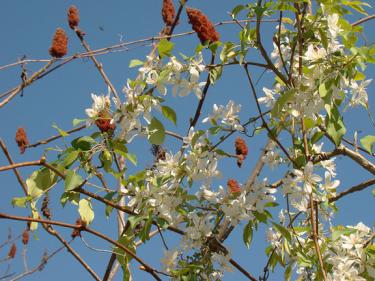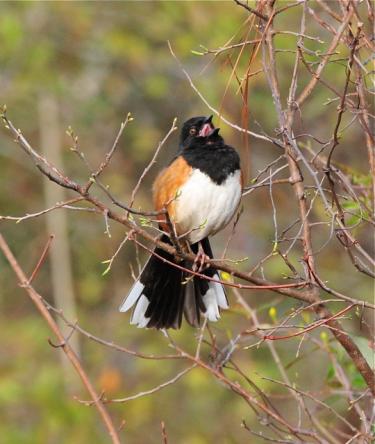Superfoods for the Birds
Most native plants hold some value for birds but certain trees, shrubs and vines offer spectacular benefits for an array of feathered critters, earning them the title of Superfood! Some of these plants offer important pre-migration foods—like fruits rich in antioxidants that help strengthen birds against the stresses of travel. Others provide food over several seasons and are particularly important over lean winter months.
Below is a list of some of the top bird superfood plants for different layers of forest vegetation. They are all native to large sections of the United States. But before planting them, do check that they are native to your region and will grow well. If you already have some of these trees growing in your woods, you can boost the benefits they offer to birds by making sure they are well cared for.
- Native wild grape (Vitis riparia): This climbing vine provides fruit in the fall to more than 50 species of birds including robins, bluebirds, catbirds and thrushes. It also creates spaces and material for nesting.
- Winterberry (Ilex verticillata): This deciduous shrub fruits in fall, but its berries will often persist into winter, providing a critical winter food source to many birds including waxwings, bluebirds and robins. Note: Only the female plants bear fruit, so you will need to get a mix of female and male plants.
- Blackberry (Rubus allegheniensis): This superfood, a low-growing shrub, provides food for more than 150 bird species! Woodpeckers, kingbirds, tanagers, sparrows and many more feast on blackberries in the fall; even in winter, after berries have fallen to the ground, birds will eat the seeds that remain when the fruit decomposes. This is a great plant to grow at the forest edge. Note: There may be a species of native blackberry specific to your region—ask at a native plant nursery.
- Elderberry (Sambucus canadensis): Waxwings, kinglets, warblers, and more than 120 other birds eat the fruit of the elderberry when it ripens from mid-summer to early fall. This large shrub also offers cover and nesting sites for birds.
Look for Eastern Towhees, like this one seen in Mississippi, in brush, tangles, thickets, and along forest edges.
- Staghorn sumac (Rhus typhina): Almost 100 different types of birds, including flickers, towhees and tanagers, find food and shelter in the sumac. The female plants of this large shrub fruit in early fall and many keep berries into spring—providing a useful winter food source.
- Gray dogwood (Cornus racemosa): A large shrubby member of the dogwood family, the gray dogwood fruits in late summer with berries that can persist into winter and help sustain almost 100 different kinds of birds. The berries of this dogwood are particularly high in fat, which helps fuel migrating songbirds over their long autumn travels. The plant, which also provides sheltering cover, is important to vireos, warblers, juncos and even wild turkeys!
- Serviceberry (Amelanchier canadensis): A beautiful under-story tree, the serviceberry grows from 25 to 60 feet high and blooms in early spring, followed by reddish berries in summer that are edible to people and an important food source for birds. More than 40 types of birds rely on the fruit of the serviceberry, from cardinals and doves to goldfinch and grosbeaks. This medium sized deciduous tree also provides good nesting sites for many birds.
- Black cherry (Prunus serotina): This large deciduous tree can grow to a height of 110 feet and along that length it provides some of the best food and shelter that native birds and butterflies can find. When the black cherry blooms in May it attracts legions of insects to help pollinate its showy blooms—which in turn draw hungry migrating warblers. Cherries ripen by August, providing abundant fruit for thrushes, orioles, waxwings, woodpeckers and many other bird species. And if that isn’t enough to recommend the black cherry, more than 400 species of butterflies and moths lay their eggs on this tree!
- White oak (Quercus alba): The white oak is another large deciduous superfood tree. This oak can grow to 100 feet tall and supports more than 60 species of birds with its plentiful acorns. Wood ducks, grouse, jays and thrashers are some of the many birds who find food, shelter and nesting sites on this towering oak.
There are many other native plants that offer important benefits to birds, some of which are listed below. When choosing a plant be sure to find the native variety, and include a mix of heights and fruiting seasons, to give birds the best year-round food options.
| Crabapple | Common Hackberry | Pagoda Dogwood | Eastern Hemlock |
| Juniper | Spicebush | Bayberry | Red Mulberry |
| Virginia Creeper | Eastern Red Cedar | Spruce | Viburnum |
Resources:
Top Ten Native Plants in Each Region: Provided by the National Wildlife Federation
How can I get more tips?
It’s simple! Enter your email below.


